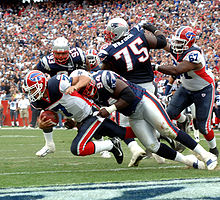
Back Safety (futbol americà) Catalan Safety (scoring) Danish Safety (Punktgewinn) German Safety Spanish Safety (points) French Safety ID Safety (football americano) Italian Safety (punkty) Polish Safety (pontuação) Portuguese Сэйфти (эпизод в футболе) Russian

In gridiron football, the safety (American football) or safety touch (Canadian football) is a scoring play that results in two points being awarded to the scoring team. Safeties can be scored in a number of ways, such as when a ball carrier is tackled in his own end zone or when a foul is committed by the offense in its own end zone. After a safety is scored in American football, the ball is kicked off to the team that scored the safety from the 20-yard line; in Canadian football, the scoring team also has the options of taking control of the ball at its own 35-yard line or kicking off the ball, also at its own 35-yard line. The ability of the scoring team to receive the ball through a kickoff differs from the touchdown and field goal, which require the scoring team to kick the ball off to the scored-upon team.[1] Despite being of relatively low point value, safeties can have a significant impact on the result of games,[2] and Brian Burke of Advanced NFL Stats estimated that safeties have a greater abstract value than field goals, despite being worth a point less, due to the field position and reclaimed possession gained off the safety kick.[1]
Safeties are the least common method of scoring in American football[3] but are not rare occurrences[2]—a safety has occurred around once every 14 games in the history of the National Football League (NFL), or about once a week under current scheduling rules.[2] A much rarer occurrence is the one-point (or conversion) safety, which can be scored by the offense on an extra point or two-point conversion attempt: these have occurred at least twice in NCAA Division I football since 1996, most recently at the 2013 Fiesta Bowl, though no conversion safeties have occurred since 1940 in the NFL. A conversion safety by the defense is also possible, though highly unlikely. Although this has never occurred, it is the only possible way a team could finish with a single point in an American football game.[A]
- ^ a b Burke, Brian (September 22, 2008). "What's a Safety Really Worth?". Advanced NFL Stats. Archived from the original on January 24, 2013. Retrieved March 10, 2013.
- ^ a b c Belson, Ken (December 8, 2011). "All That Work for 2 Points". The New York Times. Archived from the original on December 31, 2011. Retrieved November 5, 2012.
- ^ Romer, David (April 2006). "Do Firms Maximize? Evidence from Professional Football" (PDF). Journal of Political Economy. 114 (2): 340–365. doi:10.1086/501171. S2CID 9940053. Archived (PDF) from the original on October 18, 2012. Retrieved October 23, 2012.
Cite error: There are <ref group=upper-alpha> tags or {{efn-ua}} templates on this page, but the references will not show without a {{reflist|group=upper-alpha}} template or {{notelist-ua}} template (see the help page).